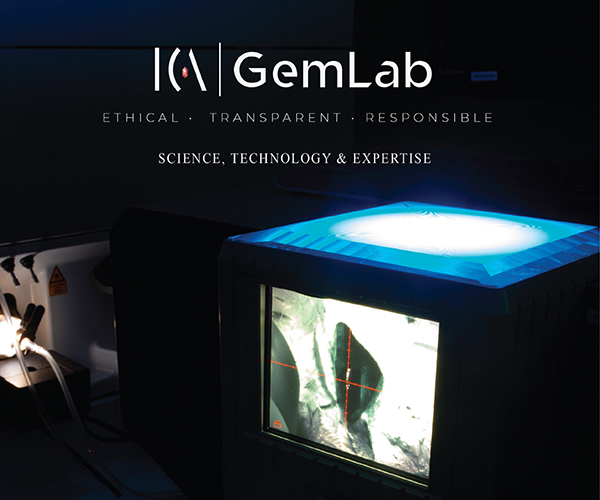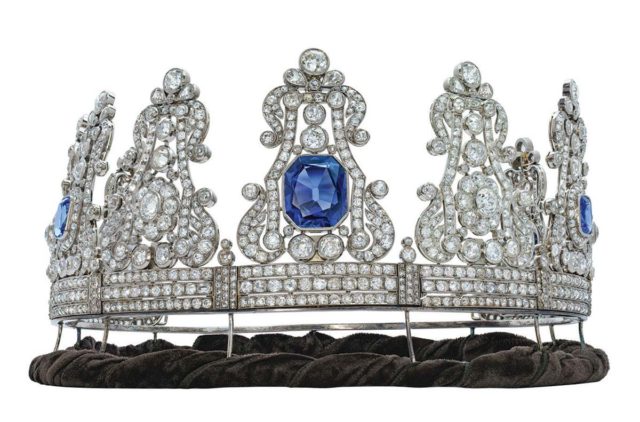
Estimated reading time: 16 minutes
The season’s major auctions, conducted by Christie’s and Sotheby’s in Geneva, Hong Kong, and New York, continue to affirm the trend that color is still in control. While important emeralds, sapphires and rubies took a large piece of the spotlight, other colorful gems, such as Paraiba tourmaline, spinel, alexandrite, and even some spectacular imperial green jadeites, were definitely not left in the shadows.
The global pandemic changed our lives in many respects and forced us to search for new ways to conduct business. The important gem and jewelry auctions were no exception, and we saw the normally live sales give way to online events.
Previewing the lots has always been an important part of any auction, but the ongoing health crisis limited viewing to by appointment- only, and then only in particular time slots. While some auction houses instituted a protective glass separation, others organized an entirely separate space where only a very restricted number of people could attend.
In 2021, with the worst of the pandemic hopefully behind us, the seasonal live auctions seemed to do better than those in 2020. After registration, it was possible for a small number of clients to attend in person. I was fortunate to be able to preview the jewels in Geneva and then attend the auction.
It was a pleasure to hold some of these magnificent treasures in my hand, not only in Geneva, but also pieces that were flown in for viewing from New York and Hong Kong.
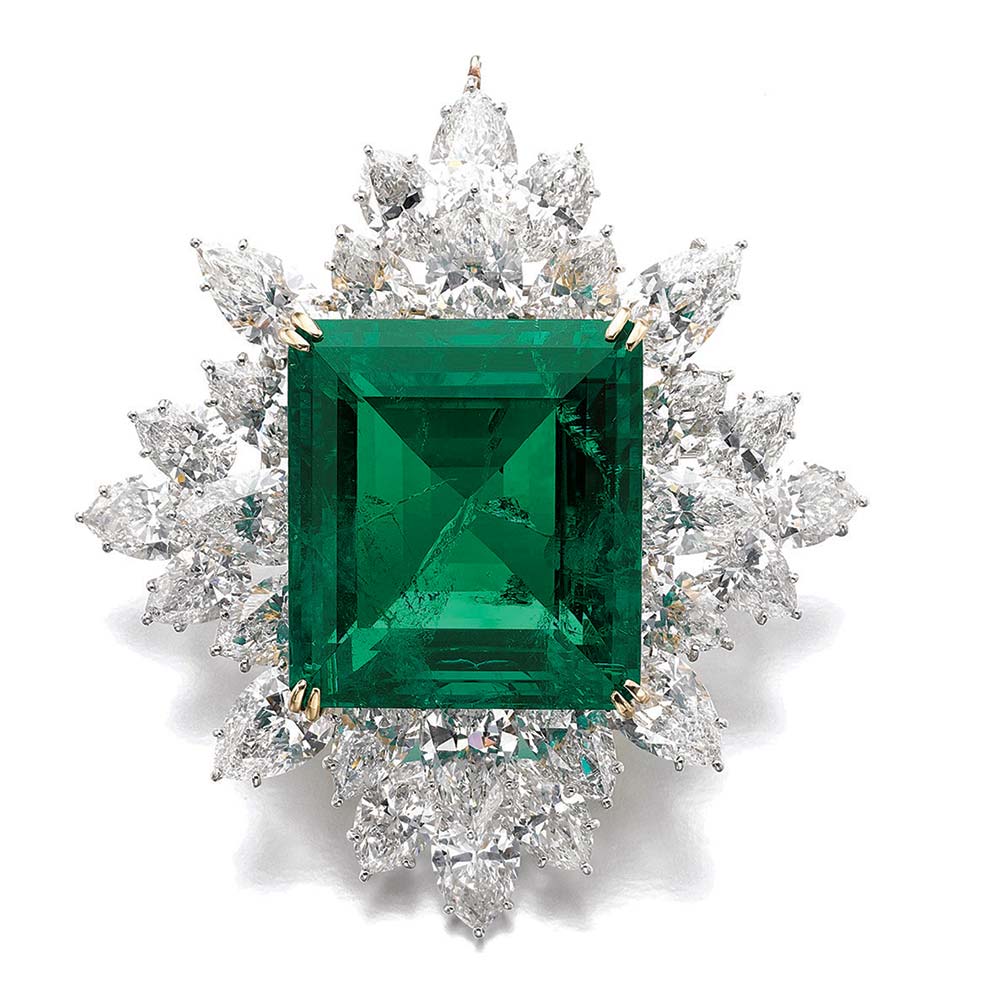
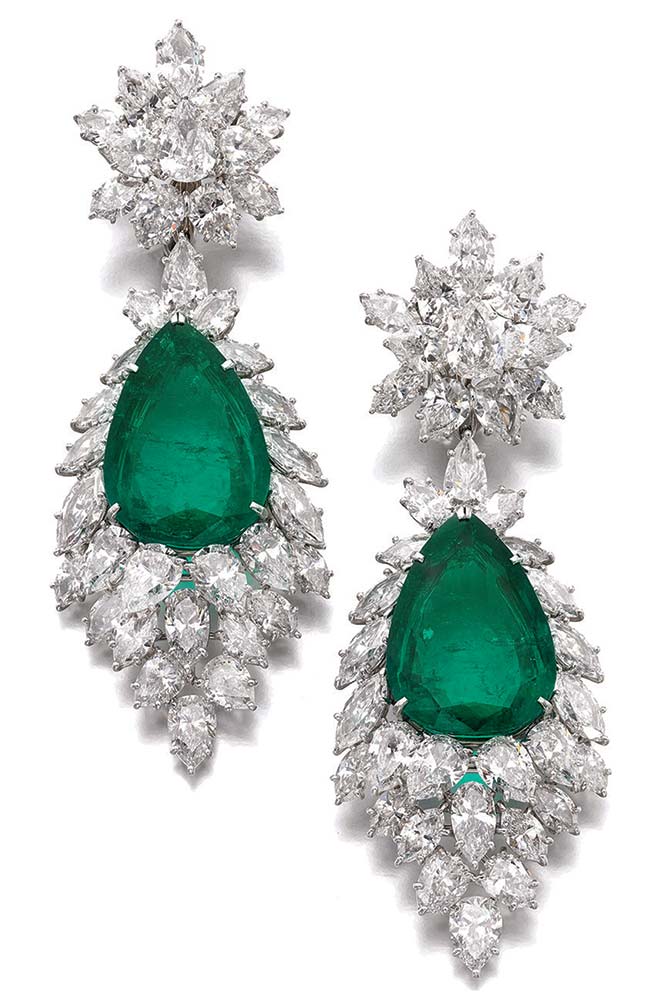
At the major auctions in these three cities, we observed a stable demand for high-quality colored gems. Buyers from around the world, attracted to the rarity of the stone as well as the brand name of the creator, kept the prices relatively stable.
As in past years, the most popular colored gems were stunning Colombian emeralds, Kashmir sapphires, and Burmese sapphires and rubies. Except for the emeralds—generally certified with Insignificant or Minor oil, which is a common practice—the other colored gems that reached premium prices were generally non-treated and non-heated.
Besides the Big Three, other colorful gems attracted a great deal of attention. These included spinels, alexandrites, Paraiba tourmalines, and Imperial jadeite, which do not appear regularly in the major auctions outside of Hong Kong.
As in the past, jewels made by global luxury brands achieved premium prices. This was especially true for pieces from a significant period or those set with exceptional gems. Antique jewels continued their upward trajectory. On these pages are just a few of the spectacular colored gemstone jewels that showed the color-full magnificence on sale at the major auctions, along with their final sales price.
Going Once, Going Twice, Going Green
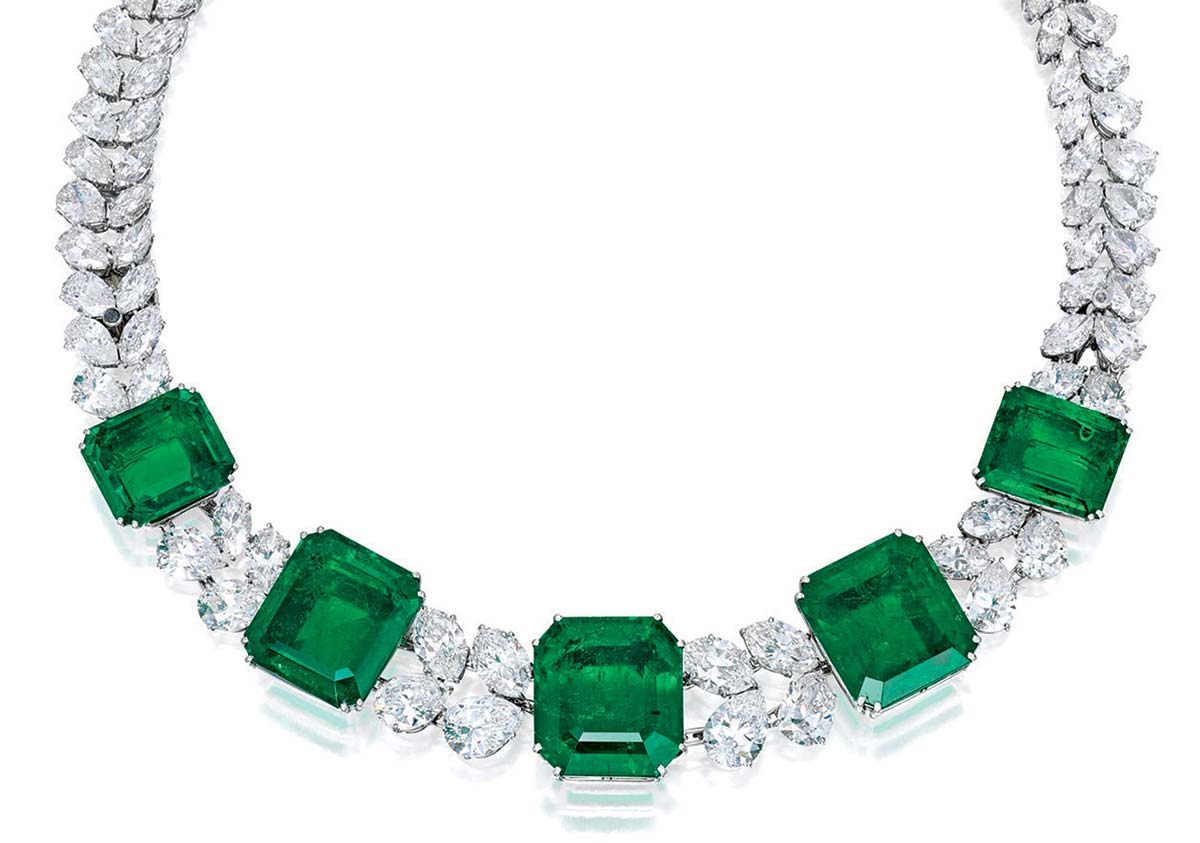
Emeralds and emerald jewelry were a large portion of the jewels on the block. Many were unsigned; some came from the major brands; others were antique pieces; and some even had impressive pedigrees or interesting stories. Prices ranged from a few thousand to well over a million dollars. The vast majority sold within their estimated range, while some went way above.
As expected, those with an interesting story or name brand recognition—Cartier, Van Cleef & Arpels, Tiffany & Co., Harry Winston, and Graff—commanded the highest prices, as did those with insignificant or minor treatment. As for origin, Colombian emeralds were the hands-down favorites.
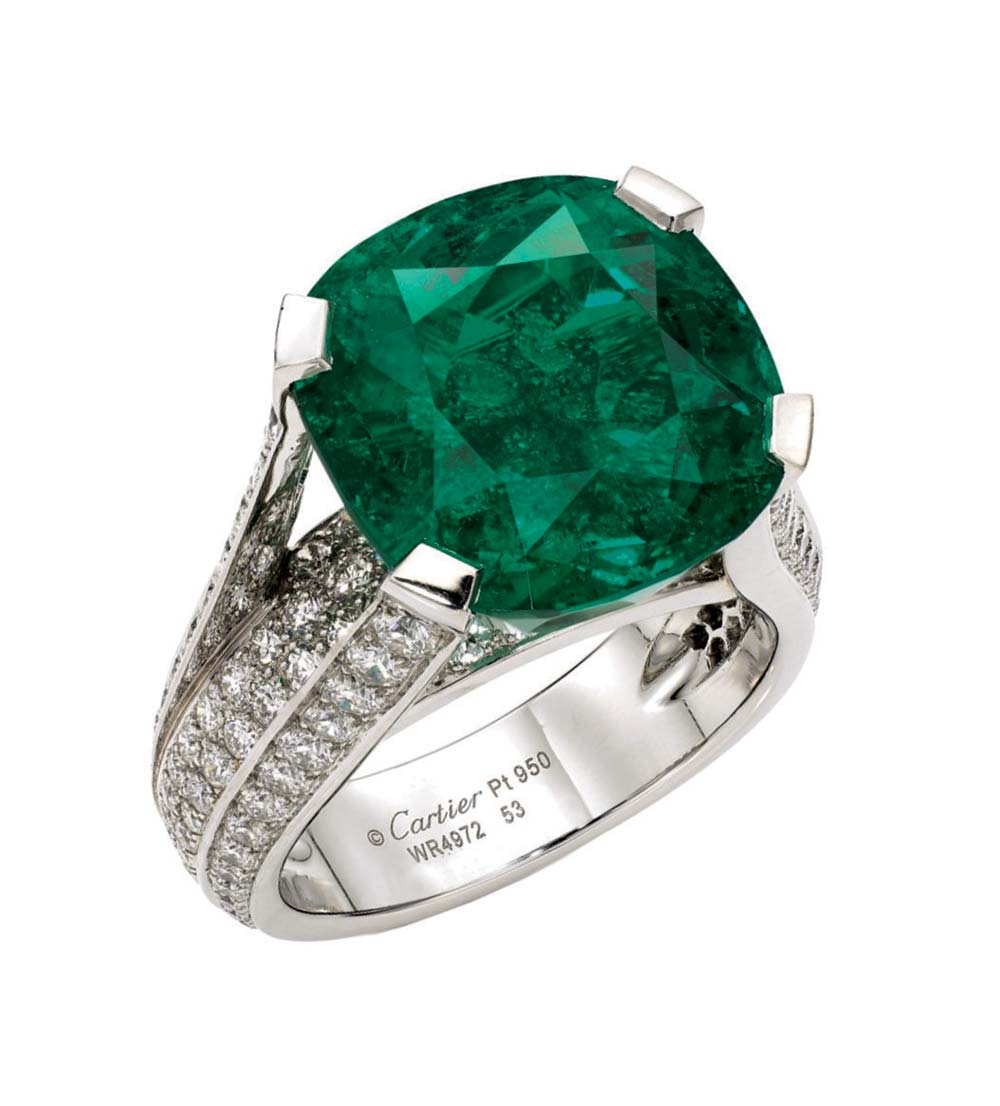
In 1947, Harry Winston was crowned by Cosmopolitan Magazine as the “King of Diamonds.” It was believed that he owned more than one-third of the world’s diamonds including the Hope and Oppenheimer. Yet, Winston also created fabulous colored gemstone jewels. Several of the brand’s emerald pieces up for auction from the Noble Collections commanded high prices.
One example was a pair of emerald (21.20 and 20.20 carats) and diamond pendant earclips from the 1970s. Of Colombian origin, the emeralds exhibited a moderate amount of oil. The pair sold for CHF1,230,000, nearly three times the highest estimate of CHF470,000 at Sotheby’s in Geneva.
Another Harry Winston piece, also from the same important Noble Collection, was an impressive emerald and diamond brooch-pendant. The 80.45-ct Colombian emerald was described as having saturated color and fine purity, with minor oil. It sold for CHF3,166,000 just under its highest estimate of CHF3,300,000.
At Sotheby’s New York, a Harry Winston emerald and diamond necklace, in platinum, pulled in US$2,803,000, above its highest estimate of US$2,500,000. With insignificant to minor treatment, the Colombian emeralds weighed between 34.01 and 13.12 carats.
Another Harry Winston piece was a 39-ct heart-shaped cabochon Colombian emerald with moderate oil, medium strong saturation. It sold way above its estimate of CHF28,000 – 42,000 Sotheby’s in Geneva for CHF151,200.
Cartier-signed emerald jewels were also on the block as seen in a 12.16-ct Colombian cushion-cut emerald and diamond ring in platinum at Sotheby’s in Hong Kong. With no indications of clarity enhancement, medium dark bluishgreen and medium strong saturation, it sold within its estimate for HKD5,983,000.
An unsigned ring with a superb octagonal step-cut 12.50-ct Colombian emerald with no indications of clarity enhancement, sold for HKD10,450,000 at Christies in Hong Kong.
Another unsigned Colombian emerald, this one weighing 24.38 carats, showing minor oil, also reached over US$1,000,000. It sold at Sotheby’s in Geneva for CHF927,500.
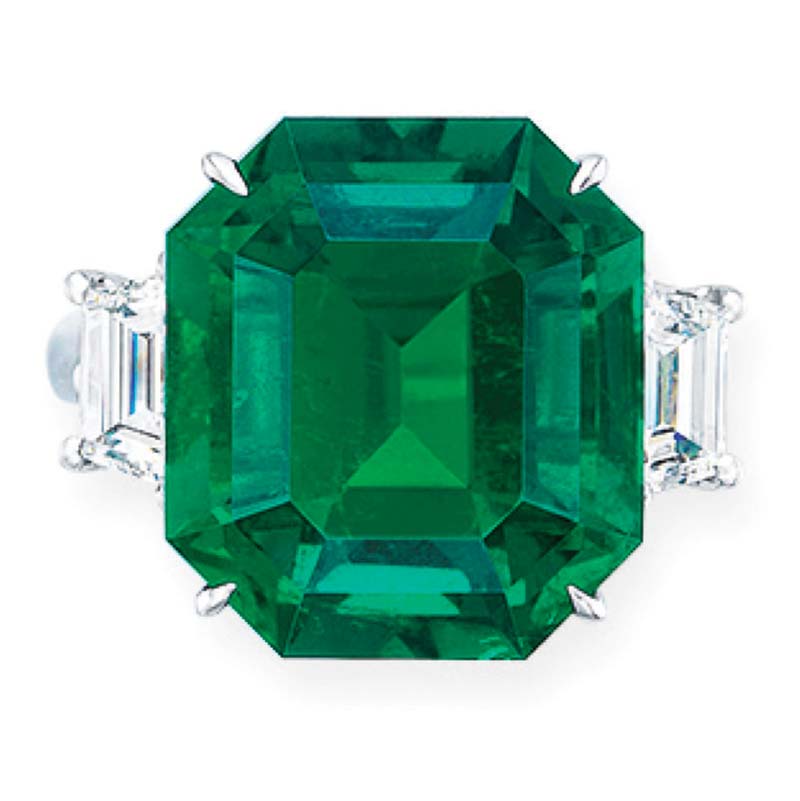
An unsigned bracelet with nineteen Colombian emeralds weighing a total of 23.80 carats with insignificant to minor treatment, sold at Christie’s Hong Kong in the middle of its range, for HKD1,000,000.

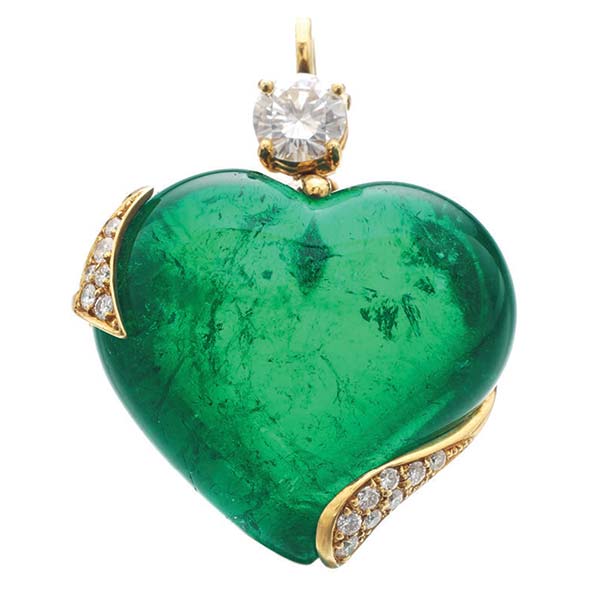
A few unmounted emeralds were also for sale, including a 108.12-ct heartshaped carved cabochon. Of Colombian origin with moderate oil, it was described as having typical inclusions and a few visible pyrite crystals. It sold at Sotheby’s Geneva for CHF81,900 within its estimate of CHF65,000 – 110,000.
Also unmounted and of Colombian origin, with insignificant clarity enhancement, were a modified rectangular step-cut 288.38-ct emerald and a square step-cut 272.51-ct emerald. The pair sold at Christie’s New York for US$600,000, more than double the high estimate of US$250,000.
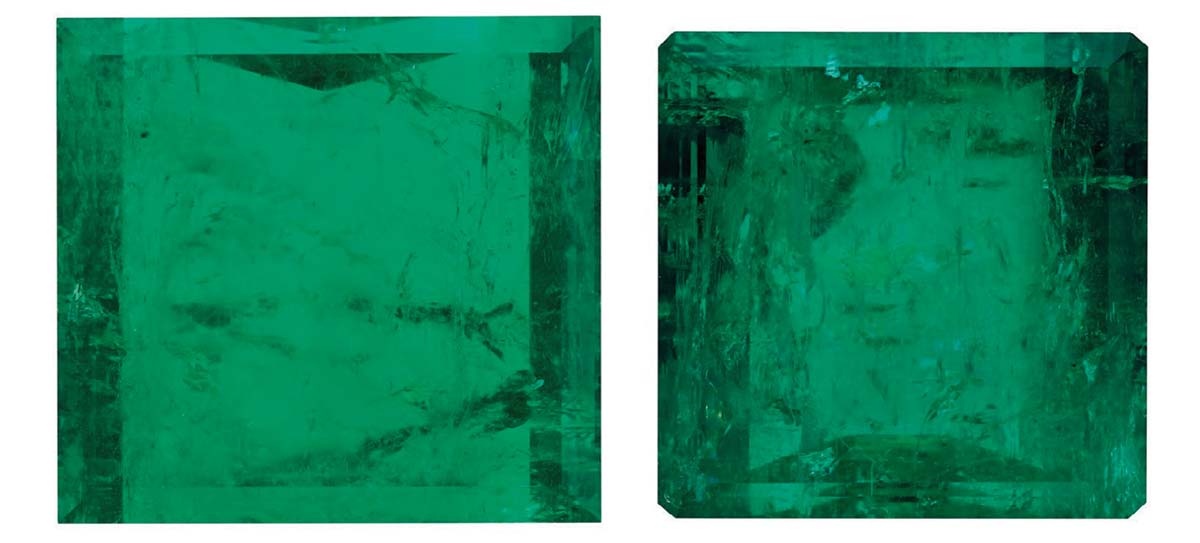
Bidding up the Blues
Sapphires also occupied a popular space at the auctions with Kashmir sapphires as ever the most coveted, followed by gems from Myanmar.
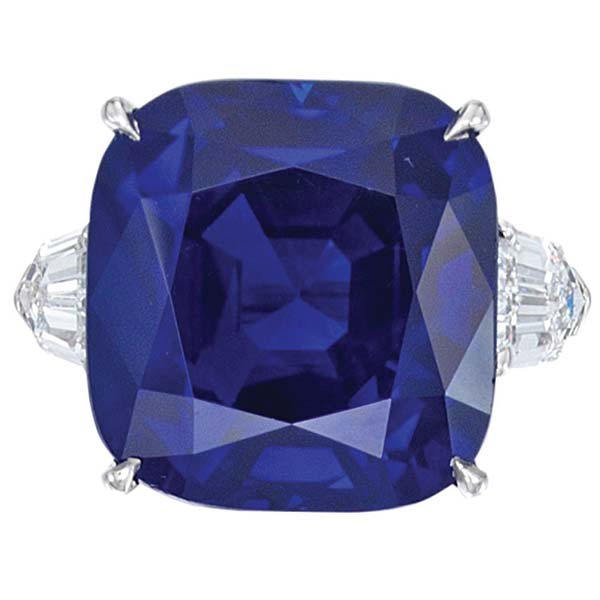
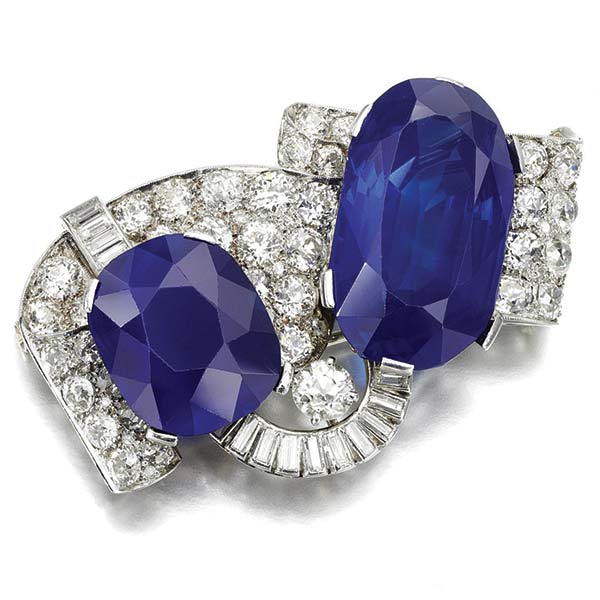
Bvlgari had a number of pieces that sold above their estimated prices. One was a 25.29-ct cushion-cut Kashmir sapphire ring, flanked by two diamonds set in platinum. The stone was described as Royal Blue, medium deep color, strongly saturated, with an overall high degree of clarity.
One of the crowning items was a 19th-century crown from a Royal Family, originally owned by Queen Maria II, Queen of Portugal and the Algarves (1819-1853), and later by William, Prince of Hohenzollern (1864-1927). Circa 1840s, it featured octagonal and oval Burmese noheat sapphires and old-cut diamonds. It sold at Christie’s Geneva for CHF1,770,000, five times its highest estimate of CHF350,000.
A noted 1930s Kashmir no-heat sapphire and diamond brooch, formerly in the collection of Maureen Constance Guinness, Marchioness of Dufferin and Ava, who was famous for her travels and philanthropy, was one of the star lots at Sotheby’s Geneva. Set with a 55.19-ct oval and a 25.97-ct cushion sapphire, the jewel was accompanied by a copy of the inventory from Hariot Hamilton-Temple-Blackwood, the Marchioness of Dufferin and Ava (1843-1936) that mentions: Two large sapphires set with diamonds as pendant – given me by people of Punjaub & sent after my return.
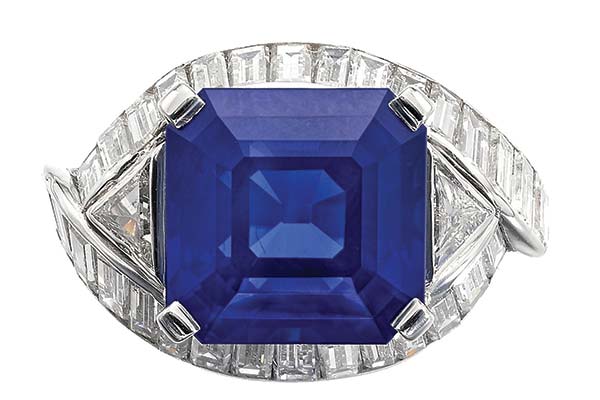
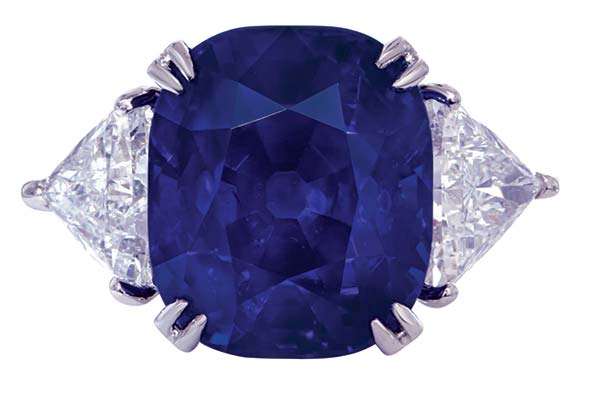
In keeping with family tradition, the sapphires were mounted in the brooch by Cartier in the 1930s. It sold for CHF3,529,000, above its high estimate of CHF2,800.000.
At the same sale, an unheated 11.33-ct step-cut Kashmir sapphire, set between triangular diamond shoulders and framed with baguette diamonds, sold for CHF1,012,200, above its highest estimate of CHF800,000. Another unsigned no-heat 16.33- ct cushion-shaped Kashmir sapphire and diamond ring sold for nearly the same price, CHF1,134,000, just under its high estimate of CHF1,200,000 at Christie’s Geneva.
Ruby Reds
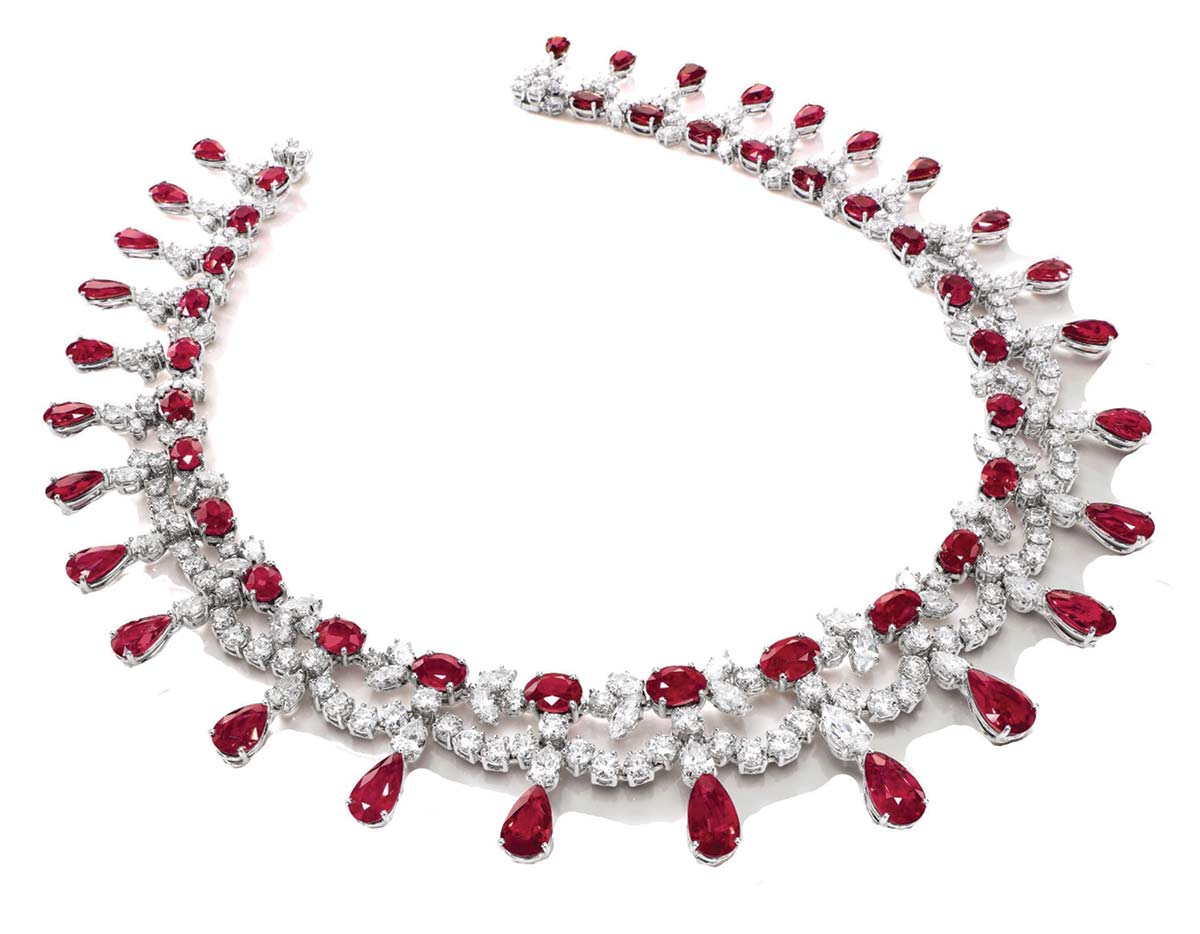
Several important rubies were sold at the auctions. Among them was an antique cushion 6.04-ct Burmese pigeon blood red ruby and diamond ring that sold for HKD14,050,000 at Christie’s Hong Kong. It showed no indications of heating.
Graff pieces in particular featured strongly. One of the world’s most recognized modern jewelers and a market-maker at auctions, Laurence Graff began his career as a bench jeweler in London doing repairs and making small pieces of jewelry. He founded his first retail shop under his own name in 1962 and, by the early 1970s, he created Graff Diamond Limited, which eventually became the single name Graff that is renowned today throughout the world.
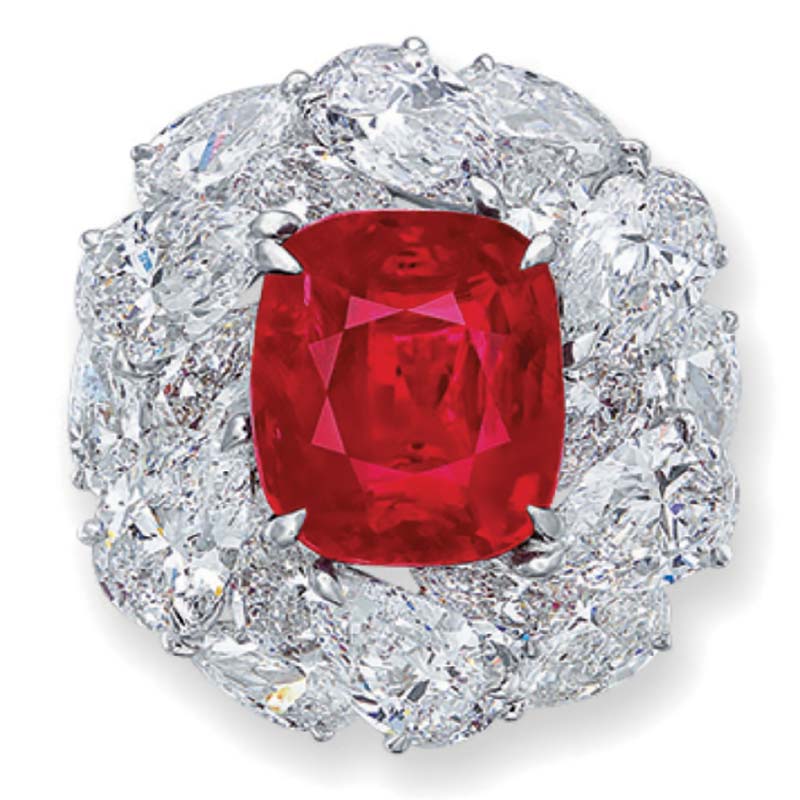
A Graff piece for sale at Sotheby’s Hong Kong was a ruby and diamond necklace set with 77.5 carats of rubies and 41.20 carats of diamonds. It, too, sold, within its estimated range for HKD2,520,000.
One of the most expensive jewels at Sotheby’s Hong Kong was a 9.10-ct Burmese no-heat ruby and diamond ring in platinum by Cartier, that settled for HKD18,930,000. The ruby was described as Burmese origin, with a medium deep purplish red color, medium strong saturation and typical inclusions and blemishes.
Fourteen oval Burmese no-heat rubies weighing a total of 28.10 carats, some considered pigeon blood red, sold at Christie’s Hong Kong for HKD1,625,000, less than its high estimate of HKD3,000,000.
One of the more spectacular prices was reached by a cushion-cut 13.02-ct Burmese no-heat ruby, accented by diamonds. Mounted by Carvin French, it was sold by a distinguished collection to benefit a charitable foundation. The hammer went down at Sotheby’s New York for US$2,500,500, above its high estimate of US$2,000,000. The ruby was a medium slightly purplish pinkish red, richly saturated, and slightly included.
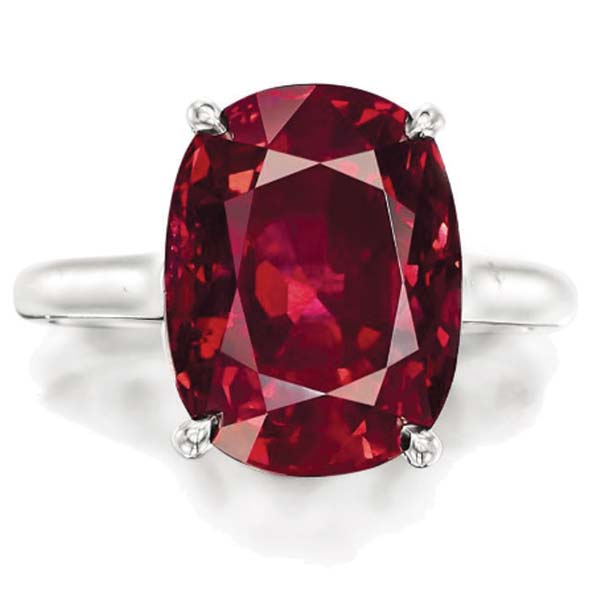
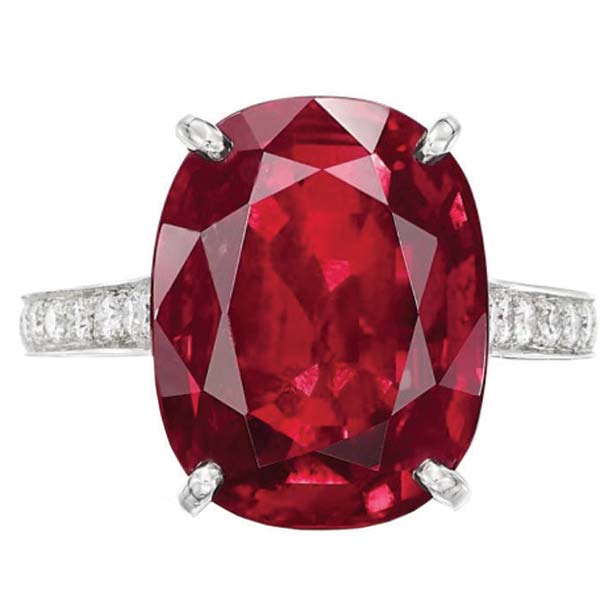
Not all rubies attaining high prices were Burmese. A 6.86-ct cushion Afghan ruby and diamond ring by Cartier drew a lot of attention, selling at Sotheby’s in Hong Kong for HKD3,780,000, well above its high estimate of HKD2,400,000. Set in platinum, accented by brilliant cut diamonds, it was described as medium slightly purplish red color, with no indications of heating.
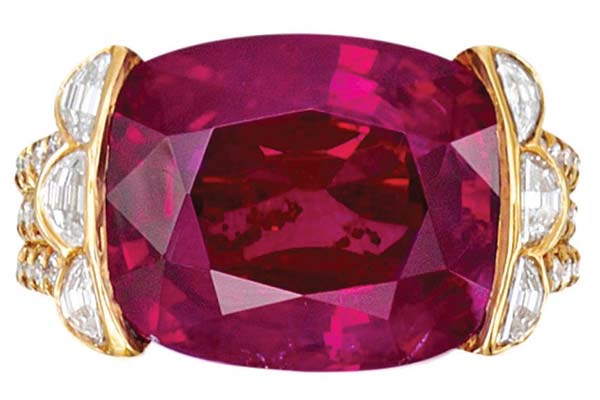
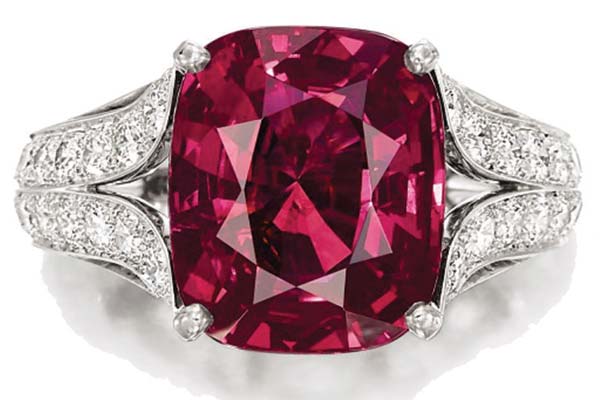
Mozambican rubies were also on sale, including a 10.13-ct ruby ring in platinum from Tiffany that sold at Sotheby’s Hong Kong, for HKD7,798,000-nearly double its high estimate of HKD4,000,000. It was described as no-heat, medium red, strong saturation, few natural inclusions, and exceptional quality for a Mozambican ruby.
And the Magnificent Others
Aside from the Big Three, the auctions offered many other fine colored gemstone jewels.
Spinel has surged in popularity over the last few years, and several pieces of spinel jewelry were up for sale. Of note were several rings, including a 32.87-ct cushion-shaped stone from Tajikistan, with diamond accents, which sold above its estimate for CHF300,000 at Christie’s in Geneva.
A 10.39-ct Burmese spinel, with no indications of clarity enhancement, sold at Sotheby’s Hong Kong for HKD1,134,000, just under its highest estimate.
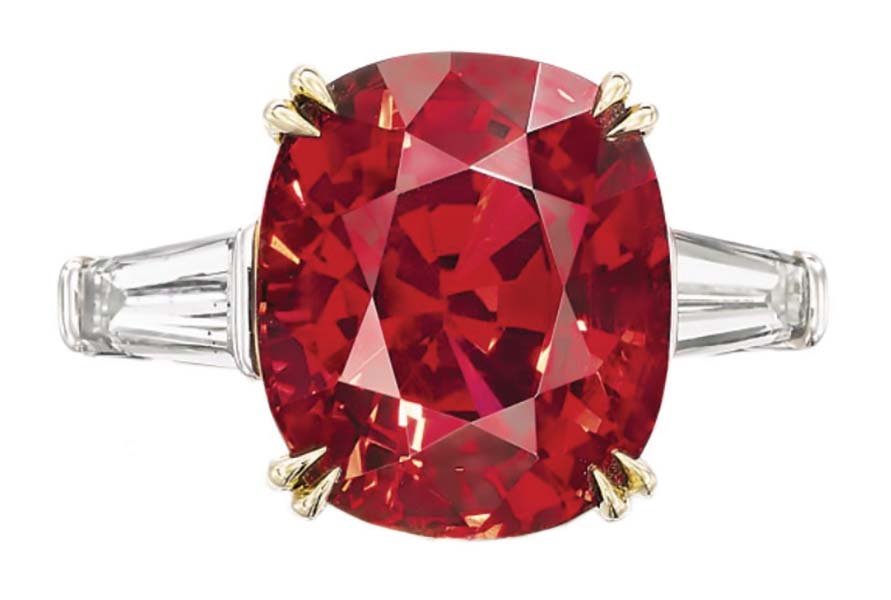
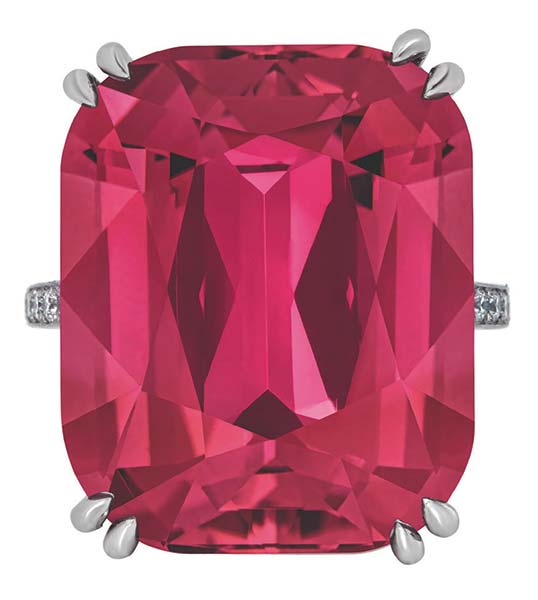
An impressive bracelet featuring 15 Burmese no-heat spinels, weighing 36.20 carats, sold at Christie’s Hong Kong for HKD4,750,000, above the highest estimate of HKD2,800,000.
Paraiba tourmaline was also a big hit at the auctions. A Lorraine Schwartz 4.22-ct Brazilian Paraiba ring sold at Christie’s New York for US$112,500.

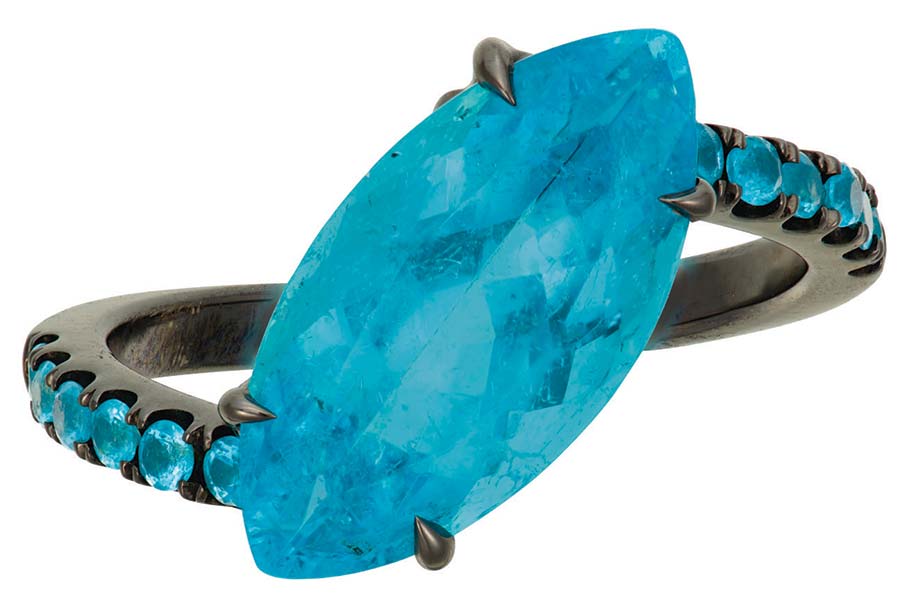
Another Brazilian Paraiba tourmaline, weighing 14.20 carats, with indications of heating and accented by diamonds, in gold, realized HKD6,250,000 at Christie’s Hong Kong.
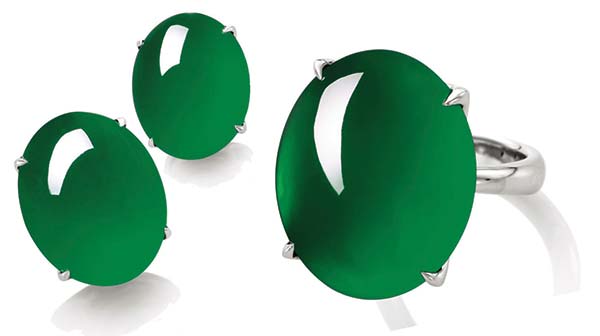
A few alexandrite jewels were sold, including an 18K gold ring set with a 3.51-ct cushion-cut gem decorated with various cuts of diamonds. Of Brazilian origin, with no evident treatments, the degree and quality of the color change was judged as excellent. It exhibited blue-green color in daylight and purple-pink under incandescent light. It and sold at Sotheby’s Hong Kong for HKD378,000 above its high estimate of HKD280,00.
While a fair number of jadeite jewels were offered, there were only a few imperial green jadeite pieces, including a pair of Burmese jadeite earrings and matching ring, offered at Sotheby’s Hong Kong.. With no indications of treatment, the 24.85-ct ring sold for HKD5,983,000, 50% above the high estimate, while the earrings (13.30 and 12.20 carats), sold for HKD6,951,000, also 50% above their high estimate.
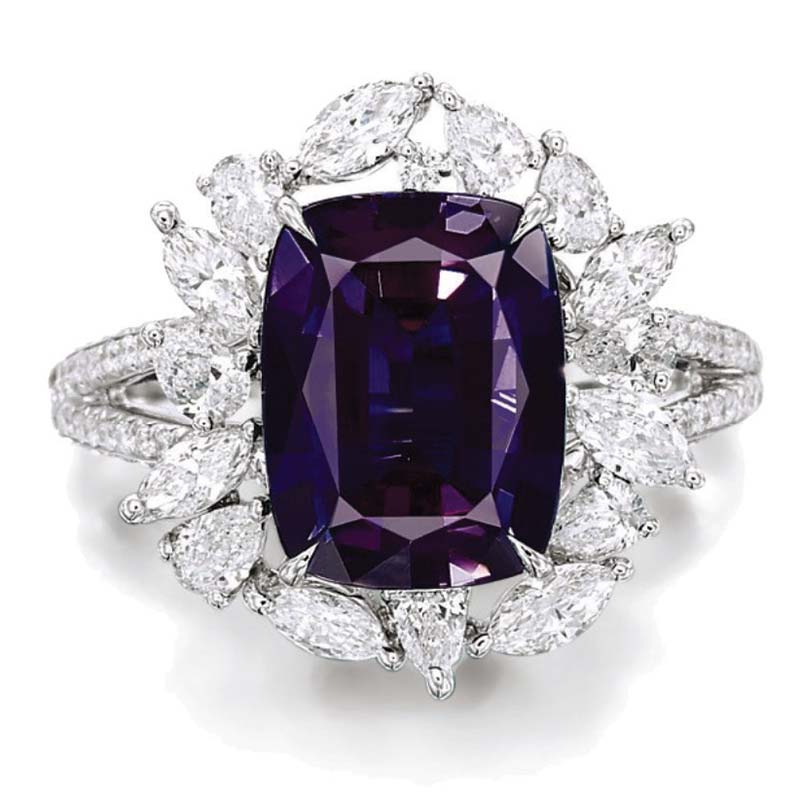

Photos are courtesy of the auction house mentioned.






